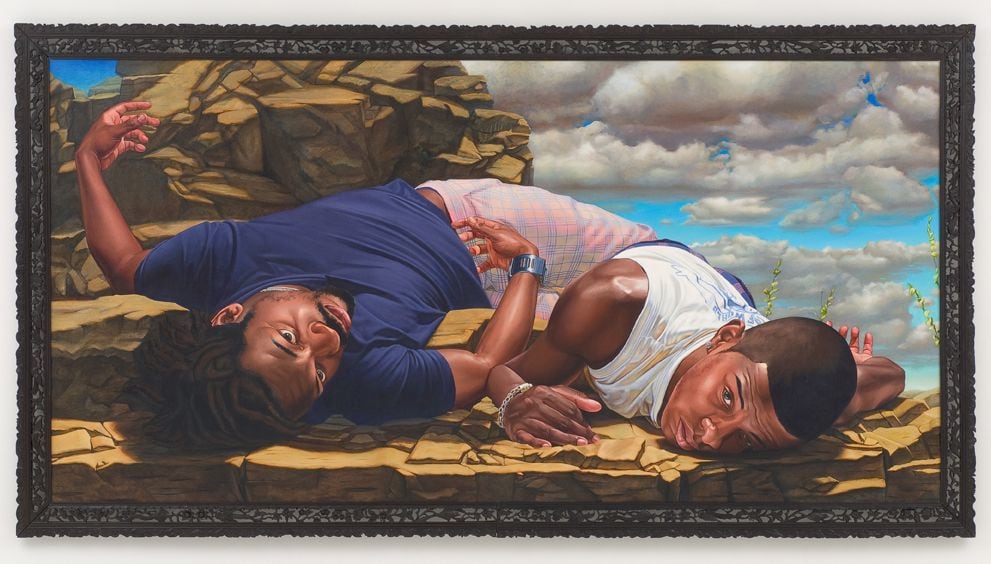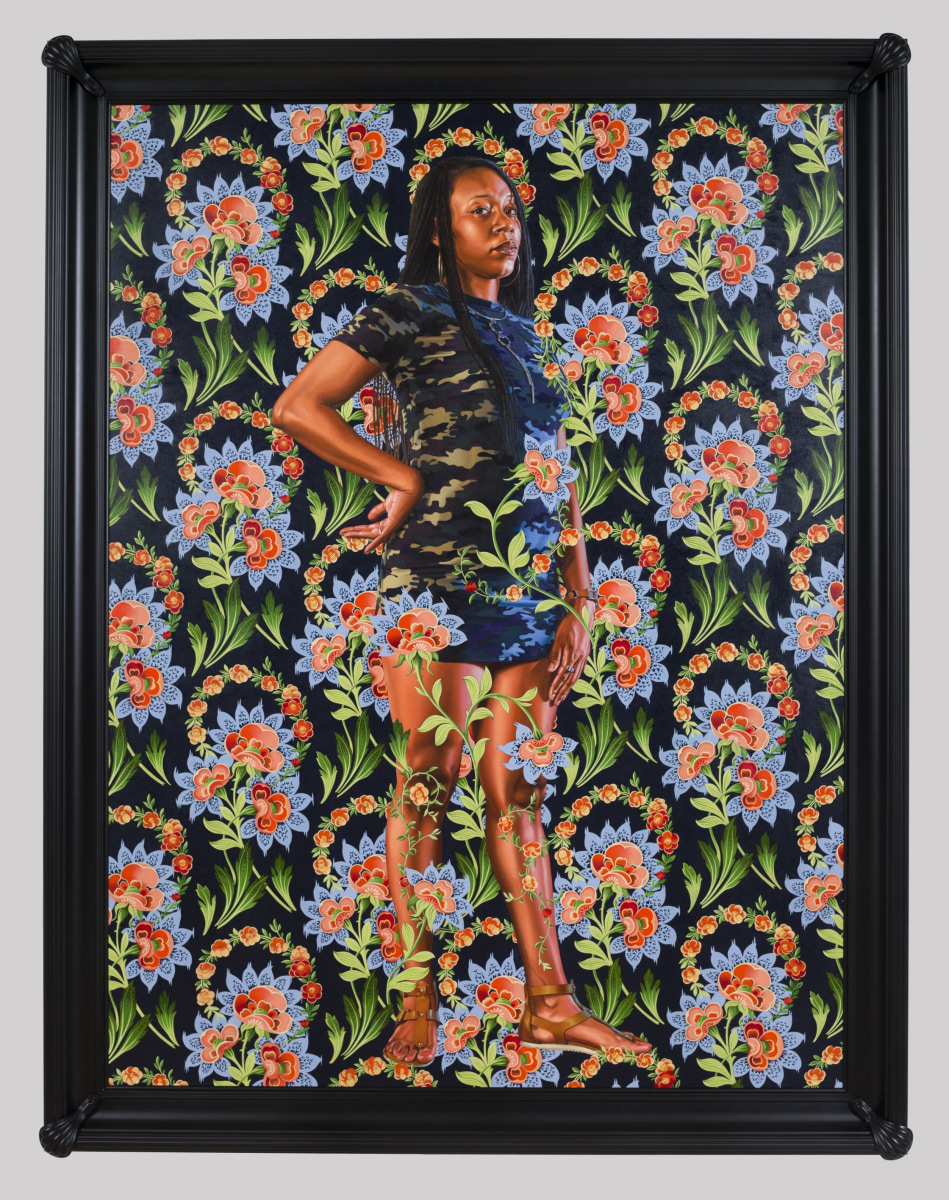Kehinde Wiley: Colorful Realm, January 21st – April 8th, 2023.
Art Opening January 21st, 2023 (6-8PM), Roberts Projects, 442 South La Brea Avenue, Los Angeles

Roberts Projects will open Colorful Realm, an exhibition of new work from renowned contemporary artist Kehinde Wiley. In conjunction with the exhibition, an extensively illustrated catalogue will be published by Roberts Projects in 2023.
Colorful Realm is the artist’s sixth solo exhibition with Roberts Projects and is the inaugural show at the gallery’s new Mid-Wilshire Los Angeles space.
To create parallels traditional techniques and materials in nine monumental paintings, the artist draws inspiration from Japanese nature paintings of the Edo period (c.1600–1868). Exposed linen highlights the depicted natural scenes while also preserving the delicate balance of the untouched picture space.
“So much of my work is about appearance and showing up and being visible, and this dance between exploring the vastness of space within the minimality of this technique I find to be an interesting juxtaposition,” the artist said to Roberts Project.

Image courtesy of Roberts Projects
Wiley references popular Edo-period artists such as Kitagawa Utamaro, Kiyohara Yukinobu, and Utagawa Kunisada in this new body of work. These references are shown in his use of negative space in compositions that significantly advance his distinct visual lexicon. The functional emptiness emphasizes the unity of nature and the vast expanse of the natural world because there is nothing else than a single topic in its place. The focal point of each painting is the story itself, one that extends beyond a path that blends into the horizon, and the understanding of the narrative as a whole. Similarly, Itō Jakuchū’s renowned Images of the Colorful Realm of Living Beings (c. 1757-1766), from which this exhibition takes its title, embodies how nature scenery is depicted and symbolized in Japanese art.
Rich compositions that blur the line between painting and devotional items feature expansive displays of flora and wildlife, both real and imaginary, portrayed in meticulous detail on raw silk. Jakuchū’s mastery in capturing these details is remarkable since it shed a lot of light on the then-contemporary concept of the connection between nature and art.

Image courtesy of Roberts Projects
Wiley expands the understanding of the political context of the divine subject, as admired by an Edo audience, by exploring painting’s role in communicating power, ritual, and performativity, and how this dialogue can shift historical memory by both incorporating and monumentalizing Black and brown men and women in art historical spaces not accustomed to their presence.
In Wiley’s reinterpretation of the Edo period’s visual vocabulary, the overlapping relationships are decidedly more global.
“This series has developed over a number of years and has involved models from different stages of my life. You’ll find models from New York, West Africa, and Europe. This exhibition is an opportunity to picture some of my favorite subjects within one body of work,” the artist said.
With this new series, Wiley recontextualizes the naturalist landscape genre from a non-Western perspective, activating different historical memories and therefore different ways of thinking about man’s relationship to nature. Generally removed from any narrative content, he re-presents the landscape as one with intersecting cultural, social, and artistic discourses. The aesthetic principles of his practice–portraits defined by their dramatic realism set against dynamic backgrounds–have expanded to incorporate a heightened appreciation for the natural world. The rigidly structured English William Morris style, as featured in Wiley’s celebrated series The Yellow Wallpaper (2020), has given way to a more organic aesthetic expression. The overall effect, in its looseness and beguiling simplicity, is more subtle, more sensitive yet more complex when seen as a whole.

In both subject matter and execution, these new works are also notable in how they emphasize a dimensional space with no end, one that extends beyond the limits of the painting itself. Wiley’s use of bold outlines and almost flat regions of color contrast against the near blankness of exposed raw linen, which becomes less of a color than a suggestion, or tone. The empty spaces connect intertwining leaves and flowers, and separate, yet link figures. In these paintings, Wiley creates presence in the physicality of absence, and this conception of spatiality and space centers not only on space itself, but on temporality, relations, negation, and negotiation. It is in this void, untied to any specific time or space, where different people, places, and experiences can be found and converge, without resistance or boundaries.
To clarify what he describes as a “divine void,” in these paintings, Wiley proposes his act of painting as one of refusal. His suspension of the figure in a sort of self-described “fabulous vacuum,” where they previously existed in a purely decorative environment, espouses an intimacy that is provocative without being exploitative. In this space, his subjects achieve a type of joy, a type of freedom, and finally, a type of impossibility. It is a state of being that is in direct opposition to the reality of how Black and brown bodies exist in contemporary American society: surviving the paucity of access to both natural and societal resources that is deliberate, cumulative, and systemic. Per Wiley, “In this new turn, I’m trying to break open the conversation again towards what nature really means in the 21st century, in an era of widespread ecological disasters. Our relationship with nature is increasingly in a perilous position. It invites a reinterpretation of not only an incredible opportunity to explore the vastness and the beauty of nature, but also the astonishing fragility and sadness that surrounds us, and lost opportunities.”

Image courtesy of Roberts Project
About the Artist
Kehinde Wiley (b. 1977, Los Angeles) is an American artist best known for his portraits that render people of color in the traditional settings of Old Master paintings. Wiley’s work brings art history face-to-face with contemporary culture, using the visual rhetoric of the heroic, the powerful, the majestic and the sublime to celebrate Black and brown people the artist has met throughout the world. Working in the mediums of painting, sculpture, and video, Wiley’s portraits challenge and reorient art-historical narratives, awakening complex issues that many would prefer to remain muted.
In Summer 2023, a monumental bronze sculpture will be unveiled at Sankofa Park, commissioned by Destination Crenshaw, Los Angeles.
Recent exhibitions include Kehinde Wiley: An Archaeology of Silence, Fondazione Giorgio Cini, Venice, Italy, a collateral event of the 59th International Art Exhibition, La Biennale di Venezia (2022); Kehinde Wiley: The Prelude, The National Gallery, London, England (2022). In 2021, The Huntington Library commissioned Wiley to create a new painting inspired by Thomas Gainsborough’s The Blue Boy (ca. 1770). A Portrait of a Young Gentleman (also the original title of the Gainsborough painting) is now in The Huntington’s permanent collection. In 2018, Wiley became the first African American artist to paint an official U.S. Presidential portrait for the Smithsonian National Portrait Gallery. Former U.S. President Barack Obama selected Wiley for this honor. In 2019, Wiley founded Black Rock Senegal, a multidisciplinary artist-in-residence program that invites artists from around the world to live and create work in Dakar, Senegal. Wiley is the recipient of the U.S. Department of State’s Medal of Arts, Harvard University’s W.E.B. Du Bois Medal, and France’s Chevalier dans l’Ordre des Arts et des Lettres (Knight of the Order of Arts and Letters). He holds a BFA from San Francisco Art Institute, an MFA from Yale University, and honorary doctorates from the Rhode Island School of Design and San Francisco Art Institute. He has held solo exhibitions throughout the United States and internationally and his works are included in the collections of over 50 public institutions around the world. He lives and works in Beijing, Dakar, and New York.
About Roberts Projects
Roberts Projects represents mid-career and established artists of international recognition as well as emerging artists. The gallery’s focus is to present a diverse and ambitious program emphasizing museum-quality, installation-based exhibitions. Roberts Projects showcases as well as commissions projects with artists who work using a variety of mediums including but not limited to drawing, painting, sculpture, photography, film and performance. By exhibiting artists across multiple generations and continents, the gallery establishes a discursive critical voice in addressing diverse perspectives of art within a broader context of contemporary artistic practices. In keeping with its priority of championing the contributions of established artists and the potential of young artists alike, the gallery periodically mounts expansive survey shows of historical note.
The gallery’s publication division produces books and catalogues focusing on exhibition surveys, contemporary artists and art historical monographs.
Roberts Projects occupies a 10,000 sq ft historic automobile showroom and features four exhibition spaces, a bookshop, and a permanent site-specific space conceived by the trailblazing artist Betye Saar. Originally the former Max Barish Chrysler-Plymouth showroom, the new space is located at 442 South La Brea Avenue, two blocks north of Wilshire Boulevard. The architectural conversion was realized by the firm of Johnston Marklee which designed Roberts Projects’ Culver City location in 2008. The firm of Buro Happold led the lighting design.
Roberts Projects was founded as Roberts & Tilton in Los Angeles in 1999 by partners Bennett Roberts, Julie Roberts and Jack Tilton. Following the passing of Jack Tilton (1951- 2017), Roberts & Tilton changed its name to Roberts Projects on January 1, 2018.
Roberts Projects is a member of the Art Dealers Association of America (ADAA), a nonprofit organization of the nation’s leading galleries in the fine arts. ADAA seeks to promote the highest standards of connoisseurship, scholarship and ethical practice within the profession since its inauguration in 1962. Members have extensive expertise across primary and secondary markets and established reputations for upholding the best practices in the field.


